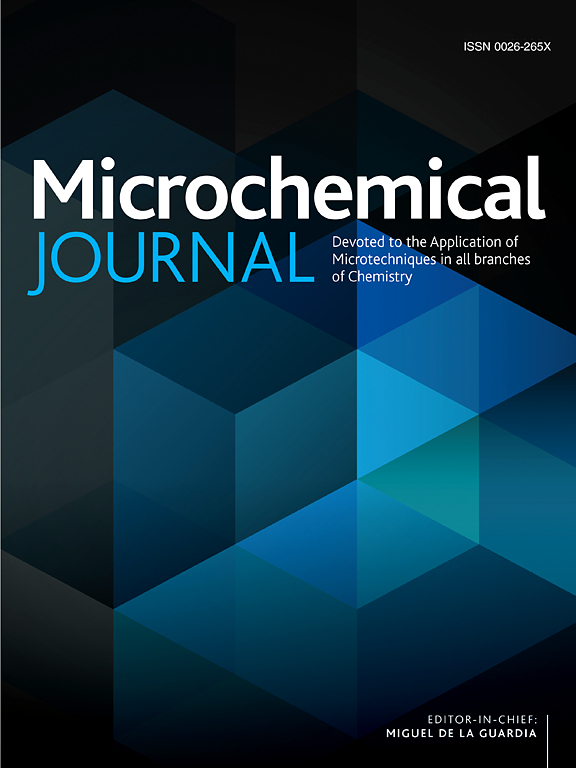Zr/多金属氧酸盐/碳纳米管三元复合材料高效分散微固相萃取酚类衍生物的研制
IF 4.9
2区 化学
Q1 CHEMISTRY, ANALYTICAL
引用次数: 0
摘要
研究了纳米锆/多金属氧酸盐/碳纳米管(ZrNP@SiW12-CNT)三组分复合吸附剂,用于水样中酚类衍生物(苯酚、2-氯苯酚、3-氯苯酚和4-硝基苯酚)的分散微固相萃取(D μ spe)。采用不同的技术研究了Zr纳米颗粒的结构和形态,其中选择keggin型多金属氧酸盐[SiW12O40]4−(SiW12)单元包封Zr纳米颗粒形成ZrNP@SiW12簇。然后,这些团簇通过多种静电相互作用组装在氧化碳纳米管(CNT)表面,形成ZrNP@SiW12-CNT复合材料。因此,具有芳香族和富氧表面(聚金属氧酸盐簇、羧酸盐和氧化碳纳米管的羟基)的ZrNP@SiW12-CNT可以作为一种合适的吸附剂,通过π堆叠、氢卤素键等静电相互作用来锚定酚类污染物(含芳环、羟基、卤素或硝基)。用气相色谱-火焰离子化检测器(GC-FID)在0.03 ~ 200 ng mL−1浓度范围内线性标定图对提取的酚类衍生物进行分析。测定的检出限为0.01 ~ 0.02 ng mL−1,表明D-μSPE-GC-FID方法可用于水样中酚类化合物的提取,相对回收率为96.6 ~ 99.9%。相对标准偏差(RSD)为3.6% ~ 4.7%。本文章由计算机程序翻译,如有差异,请以英文原文为准。
Development of Zr/polyoxometalate/carbon nanotube ternary composite for the efficient dispersive micro solid-phase extraction of phenolic derivatives
In this work, a tri-component composite containing zirconium nanoparticles/polyoxometalate/carbon nanotube (ZrNP@SiW12-CNT) was developed as sorbent for the dispersive micro solid-phase extraction (D-μSPE) of phenolic derivatives (i.e. phenol, 2-chlorophenol, 3-chlorophenol, and 4-nitrophenol) from water samples. The structure and morphology of the sorbent were studied by different techniques in which the Zr nanoparticles were chosen to be encapsulated by Keggin-type polyoxometalate [SiW12O40]4− (SiW12) units to form ZrNP@SiW12 clusters. Then, these clusters are assembled on the surface of oxidized carbon nanotube (CNT) by many types of electrostatic interactions to form ZrNP@SiW12-CNT composites. Therefore, ZrNP@SiW12-CNT with aromatic and oxygen-rich surface (oxo-groups from polyoxometalate (POM) clusters, carboxylate, and hydroxy groups of oxidized CNT) can be a suitable sorbent to anchor phenolic pollutants (containing aromatic ring, hydroxyl group, and halogen or nitro groups) via electrostatic interactions like π-stacking, hydrogen and halogen bonding. The extracted phenolic derivatives were analyzed using a gas chromatography-flame ionization detector (GC-FID) with linear calibration plots in the concentration range of 0.03–200 ng mL−1. The limits of detection (LODs) were determined as 0.01–0.02 ng mL−1 which showed that the D-μSPE-GC-FID method is valid for the extraction of phenolic derivatives from water samples with relative recovery values of 96.6–99.9 %. Also, the relative standard deviation (RSD) range was 3.6–4.7 %.
求助全文
通过发布文献求助,成功后即可免费获取论文全文。
去求助
来源期刊

Microchemical Journal
化学-分析化学
CiteScore
8.70
自引率
8.30%
发文量
1131
审稿时长
1.9 months
期刊介绍:
The Microchemical Journal is a peer reviewed journal devoted to all aspects and phases of analytical chemistry and chemical analysis. The Microchemical Journal publishes articles which are at the forefront of modern analytical chemistry and cover innovations in the techniques to the finest possible limits. This includes fundamental aspects, instrumentation, new developments, innovative and novel methods and applications including environmental and clinical field.
Traditional classical analytical methods such as spectrophotometry and titrimetry as well as established instrumentation methods such as flame and graphite furnace atomic absorption spectrometry, gas chromatography, and modified glassy or carbon electrode electrochemical methods will be considered, provided they show significant improvements and novelty compared to the established methods.
 求助内容:
求助内容: 应助结果提醒方式:
应助结果提醒方式:


